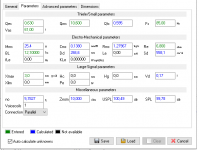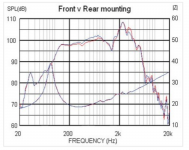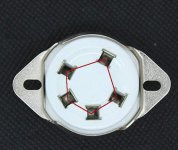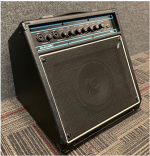I was unable to find any Thiele-Small parameters for the G12-T75, otherwise I would have at least run a simulated frequency response (with and without an additional 10 ohms - 50 ohms in series).
Here, enjoy. When designing it I assumed 25 ohms which produce a bump at 150Hz but the intentionally designed wide baffle somewhat coincides this with the baffle step loss so the actual bump is less than 3db, in theory (haven`t measured it and will not). This is an old trick to make a speaker with higher Fsc sound more dynamic. The rise in group delay is very narrow in frequency and will affect one or two notes at best, however below the Fsc this tuning yields lower group delay compared to a conventional Qtc 0.6-0.7 design. Adding to this the rigid box and some absorption, compared to the usual 16mm particle board cab, I don`t see how it could be flabby. Turned out really nice and today went to have a bath in porcelain white paint
Attachments
Thanks for the data, and also for sharing some of the thoughts behind your design!Here, enjoy.
-Gnobuddy
> backwave absoroption to reduce the smearing caused by the backwave wave leaving through the thin paper cone with a delay
- work out a cabinet where standing waves are reduced
- work out edge diffraction by offseting the guitar driver (roundeovers will be impractically large here) and reduce sharp edges
- use diffusors or irregular inner shape to further kill standing waves
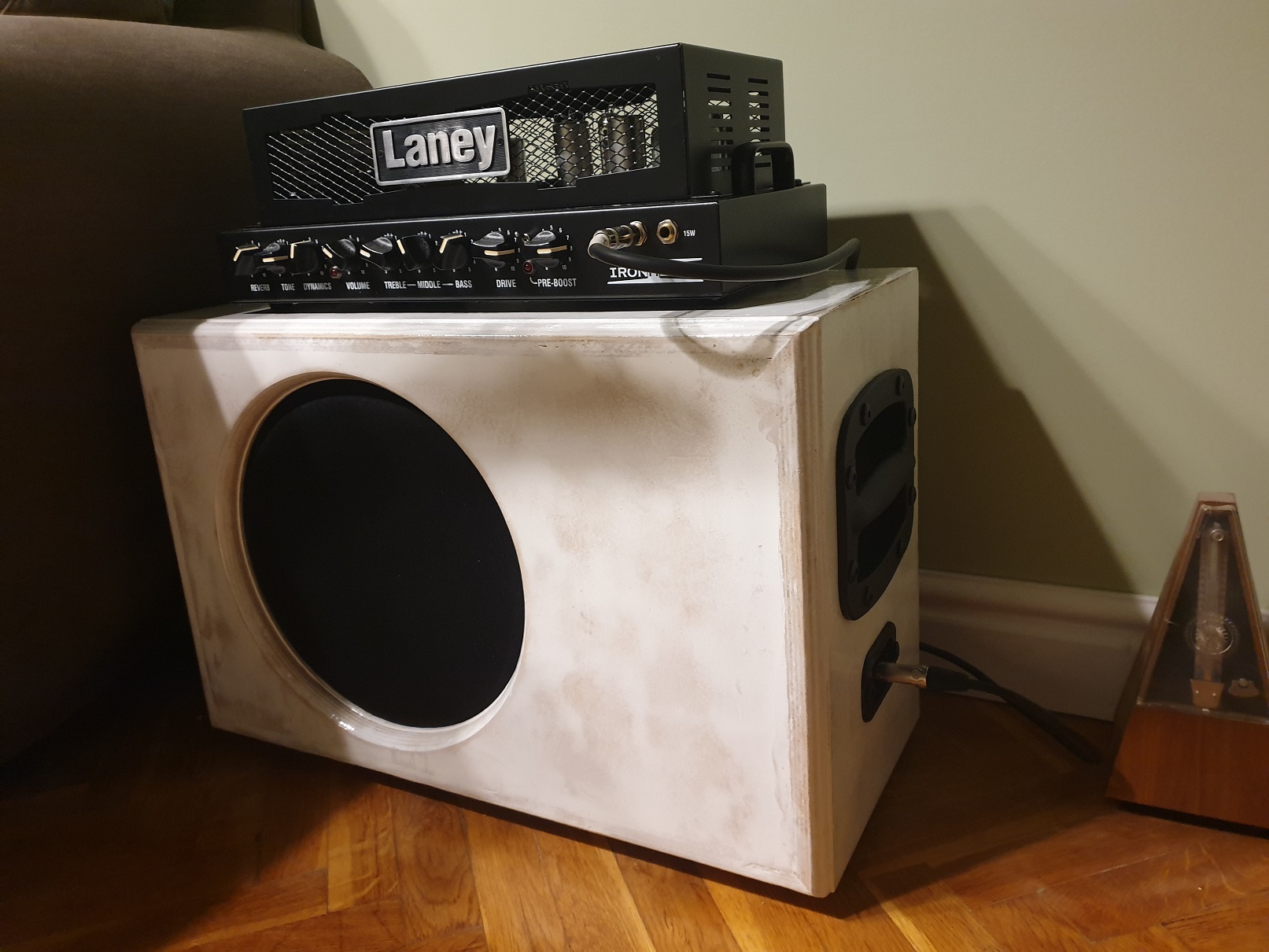
After your thoughtful thinking, I'm startled to see the driver rear-mounted. On my first "hi-fi" (hah!) cabinet I quickly heard the extra resonance from rear-mounting, switched to front-mount for all but low woofers (<200Hz) and horns where the cavity was part of the design.
Yes the cone is more exposed but there are stand-out grilles.
- work out a cabinet where standing waves are reduced
- work out edge diffraction by offseting the guitar driver (roundeovers will be impractically large here) and reduce sharp edges
- use diffusors or irregular inner shape to further kill standing waves
After your thoughtful thinking, I'm startled to see the driver rear-mounted. On my first "hi-fi" (hah!) cabinet I quickly heard the extra resonance from rear-mounting, switched to front-mount for all but low woofers (<200Hz) and horns where the cavity was part of the design.
Yes the cone is more exposed but there are stand-out grilles.
Thanks Mario, very usefulHere, enjoy. .........
After your thoughtful thinking, I'm startled to see the driver rear-mounted. On my first "hi-fi" (hah!) cabinet I quickly heard the extra resonance from rear-mounting, switched to front-mount for all but low woofers (<200Hz) and horns where the cavity was part of the design.
Yes the cone is more exposed but there are stand-out grilles.
Well, I don`t like backmounted drivers but here I had to work with the following constraints:
- protect driver without to have a grille extending on the front
- the Celestion has the gasket on the front and its thick which makes it a bit tricky to panel mount and keep some good look
- I didn`t have enough grill cloth for a full cover (rectangular one for the front baffle) and didn`t want to wait for new to be shipped
I totally agree, this is far from optimal but here had to do a sacrifice. The hole is rounded over with a 1" bit, however.
It's the "21 mm deep" that matters - you have a (short) organ pipe that's 21 mm long.Where is this free resonance for a large 300mm hole that is 21mm deep and has a large roundover?
The big diameter will add some effective length ("end correction"). Usually the end correction is 0.6 times the radius, so in your case, it would be 90 mm, making the effective pipe length 111 mm. (But this end correction may not apply to such a short, fat pipe; I think computational fluid dynamics modelling might be required to get an exact answer for this one!)
The fact that your short fat pipe has a big roundover probably makes it act like a crude horn, which may make the organ-pipe resonance a little louder than without a roundover, because of better coupling to the air because of the horn.
Roundovers do reduce diffraction effects, so they're nice to have on the outer edges of a speaker cab. I don't think they help solve the problem of back-mounted drivers and thick baffles, though.
If we proceed on the assumption that the end correction is 90 mm, so that pipe length is 111mm, and we assume 20 deg C (68 F) room temperature, the first organ pipe resonance for a 111 mm long pipe is at about 1.55 kHz, with harmonics at 3.1 kHz, 4.65 kHz, 6.2 kHz. At least the first two of those are solidly in the electric guitar's frequency spectrum.
I really don't know if we can trust this simple approximation (end correction of 0.6 radius) when the pipe is so very short, and so very fat. But resonance frequencies predicted by the application of this approximate theory are low enough to colour e-guitar sound, which is interesting, and I think it may be worth some experimental investigation.
Someone has got to have done this already - maybe there are measured frequency responses out there, showing the effect of back-mounting in a 21 mm thick baffle (that's between 7/8" and 13/16" for our American friends.)
Edit: this shows up to 5 dB change in frequency response at 3 kHz, comparing front vs rear mounting: Should I front- or rear-mount a speaker onto the cabinet baffle?
-Gnobuddy
Last edited:
Where is this free resonance for a large 300mm hole that is 21mm deep and has a large roundover?
It is quite tiny.
At a different range of scale: in-ear monitor, when I compress the foam ear-tip to fit my small ear, the foam "swells" past the end of the sound tube, and forms a few-mm horn/resonator, with wicked gain above 10kHz.
A hole 300mm expanding to 340mm over 21mm will be a very small effect. In context of a Guitar speaker, negligible compared to all the paper resonances most g-speakers are riddled with.
Celestion's data attached (from the link in my previous post.)In context of a Guitar speaker, negligible compared to all the paper resonances most g-speakers are riddled with.
There's almost a 5 dB difference at 3 kHz in this particular example. Whether that is significant on top of all the other guitar-speaker peaks and valleys is up for debate.
-Gnobuddy
Attachments
There are also the forte guitar cabs. they had reflectors inside and slots/holes on the sides to direct the back wave.
Now you've done it! He Who Shall Not Be Named Without Threats Of A Lawsuit is going to appear in your home, inside a 5-pin (pentagonal) 807 tube socket....Dumble...
More seriously, Fuchs Audio Technology has used acoustic damping wool inside their guitar cabs for years, along with such other sacrilegious practices as using small cooling fans to keep chassis temperatures where they belong.
I tend to throw a cheap Walmart pillow inside every small guitar cab I make. Acoustic filling is most effective in the middle of the cab's air volume, where the air velocities are highest, rather than on the cabinet walls, where there are acoustic nodes (and therefore no air movement!)
The pillow causes a small but audible reduction in boxiness, which I prefer.
As usual with music and creative arts, there isn't a single correct way to build a guitar cab. I have heard good guitarists who use a "boxy" sounding cabinet as part of their guitar tone, to good effect. These guitarists are usually going for an overdriven, midrange-dominant sound, and the "boxy" cab helps achieve that.
I'm a little surprised nobody's brought up electro-acoustic guitar cabs yet. Most "acoustic" guitars are plugged in these days, and many of the small acoustic guitar (combo) amps I've heard sound atrocious to varying degrees. Some are so boxy, they sound as though you're somehow playing your guitar inside a bucket.
In my experience, electric guitars are relatively insensitive to bad cabinet acoustics, while (electro-)acoustic guitar's are much more sensitive to them, so poor cab design really does a number on your acoustic-guitar sound. But most acoustic guitar amplifier manufacturers don't put much effort into their cab design.
For years now I've continued to use an Acoustic AG30 I bought as my "starter" acoustic guitar amplifier; I keep using it because it's less boxy-sounding than anything else I've heard even at at twice the price.
Probably not coincidentally, the tuned, slot-loaded, bass reflex cabinet is far from the usual right rectangular prism ("brick") shape (see photo), and only two of the six cabinet walls (the two side walls) are actually parallel to each other. This probably weakens internal standing waves considerably.
-Gnobuddy
Attachments
An open back guitar cabinet is like an untuned vented box, there is a missed
opportunity to tune it to the lowest note on the instrument and gain MaxSPL
capability. Even tighten up the bass.
Its too bad that combo amps leak badly because there is no divider between
the box and the amp. It could be tried out on a head/box setup but I've not
done it yet.
Also unfortunate that a combo needs the back open for tube cooling.
opportunity to tune it to the lowest note on the instrument and gain MaxSPL
capability. Even tighten up the bass.
Its too bad that combo amps leak badly because there is no divider between
the box and the amp. It could be tried out on a head/box setup but I've not
done it yet.
Also unfortunate that a combo needs the back open for tube cooling.
An open back is just a U-frame dipole.
I think the reasons behind the how and why behind guitar cabinets is a bit of a chicken-egg story.
From a technical point of view, I agree with the topic starter.
Basically it is just VERY poorly designed and on many aspects very clearly optimized for max production efficiency at minimum costs.
This is even more true for guitar speakers, which are HEAVILY overpriced.
For less money you basically get more metal and more magnet for a much better performing PA speaker.
Most $70-$150 guitar speakers are worth like $15-$30 equivalent.
From Celestion I have even seen the same baskets/frames and magnets being used for the PA speakers for a much lower price-tag.
Another part also just has to do from what the experience and knowledge was back in the day.
Everything else is just copied from there.
So than a more philosophical question rises, what if our guitar "heros" would have played on better constructed guitar cabinets?
I have build and developed both, and even with a hi-fi or pro/PA-audio type cabinet, you can get a very good sounding guitar amp.
There is especially a lot to win when using BR cabinets with certain speakers.
Plus you have to spend a bit more time on "sound-shaping" (different EQ/tone controls etc)
The main thing is, that it will sound just a little different.
Not better or worse, just different.
And for a lot of people different mains not as good.
I think the reasons behind the how and why behind guitar cabinets is a bit of a chicken-egg story.
From a technical point of view, I agree with the topic starter.
Basically it is just VERY poorly designed and on many aspects very clearly optimized for max production efficiency at minimum costs.
This is even more true for guitar speakers, which are HEAVILY overpriced.
For less money you basically get more metal and more magnet for a much better performing PA speaker.
Most $70-$150 guitar speakers are worth like $15-$30 equivalent.
From Celestion I have even seen the same baskets/frames and magnets being used for the PA speakers for a much lower price-tag.
Another part also just has to do from what the experience and knowledge was back in the day.
Everything else is just copied from there.
So than a more philosophical question rises, what if our guitar "heros" would have played on better constructed guitar cabinets?
I have build and developed both, and even with a hi-fi or pro/PA-audio type cabinet, you can get a very good sounding guitar amp.
There is especially a lot to win when using BR cabinets with certain speakers.
Plus you have to spend a bit more time on "sound-shaping" (different EQ/tone controls etc)
The main thing is, that it will sound just a little different.
Not better or worse, just different.
And for a lot of people different mains not as good.
Last edited:
Yeah guitars are about tone and the speaker is big part of it. No need for lows and the need to mellow some of that edgy high mid sound = large "full range" speaker in open baffle is just the right recipe.
Replace the poorly designed cab with say passive small studio monitor or a hifi speaker and the ears start to bleed the tweeter disperces the bad highs and noise all around instead of beaming it to the knee.
the tweeter disperces the bad highs and noise all around instead of beaming it to the knee.
Anyway, thats the easiest and cheapest way to get good sound out of guitar, use simple cab with simple speaker driver. You can even use a broken cone driver, mo distortion is always better.
Jazz guys might have their speaker closer to the ear, closed cab perhaps, but they have the honey tone in the fingers.
ps. I play el. bass and best tone is in the hifi speaker (for me). All speaker I've tried have weird tone to my ear. Some bass cabs have a tweeter, all of them have been a joke. Haven't tried all of them of course, maybe there is a good one. Gotta build road ready constant directivity hifi bass speaker at some point
Replace the poorly designed cab with say passive small studio monitor or a hifi speaker and the ears start to bleed
Anyway, thats the easiest and cheapest way to get good sound out of guitar, use simple cab with simple speaker driver. You can even use a broken cone driver, mo distortion is always better.
Jazz guys might have their speaker closer to the ear, closed cab perhaps, but they have the honey tone in the fingers.
ps. I play el. bass and best tone is in the hifi speaker (for me). All speaker I've tried have weird tone to my ear. Some bass cabs have a tweeter, all of them have been a joke. Haven't tried all of them of course, maybe there is a good one. Gotta build road ready constant directivity hifi bass speaker at some point
Last edited:
tmuikku,
We may share some tastes in bass rig design:
My current rig is a two-way cab with a Beyma 12" (12P1000Nd) and a Beyma 6½" (605Nd) with a crossover at 500Hz. So no "instrument"-type speakers here.
It may not be uni-directional, but it does provide a dispersion in mid-range and up that works when standing close to the speaker (as in a small practice room or on a small stage)
The tweeters seen on standard bass guitar speakers are just for laugh. Sure, they may provide a small benefit directly in front of the speaker, but with a 45+ degree listening angle (as when standing close to the speaker) they will not be able to do anything with the reduced output from typical 400Hz and up.
I know: the 400Hz is heavily dependent on the speaker configuration, but I am using the almost standard 4 X 10" configuration as reference.
Cheers, Martin
We may share some tastes in bass rig design:
My current rig is a two-way cab with a Beyma 12" (12P1000Nd) and a Beyma 6½" (605Nd) with a crossover at 500Hz. So no "instrument"-type speakers here.
It may not be uni-directional, but it does provide a dispersion in mid-range and up that works when standing close to the speaker (as in a small practice room or on a small stage)
The tweeters seen on standard bass guitar speakers are just for laugh. Sure, they may provide a small benefit directly in front of the speaker, but with a 45+ degree listening angle (as when standing close to the speaker) they will not be able to do anything with the reduced output from typical 400Hz and up.
I know: the 400Hz is heavily dependent on the speaker configuration, but I am using the almost standard 4 X 10" configuration as reference.
Cheers, Martin
- Status
- This old topic is closed. If you want to reopen this topic, contact a moderator using the "Report Post" button.
- Home
- Live Sound
- Instruments and Amps
- Most guitar cabs designed poorly?
